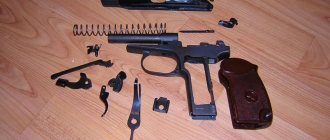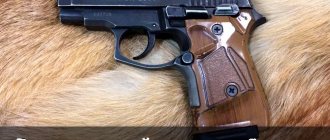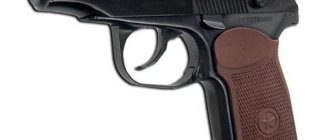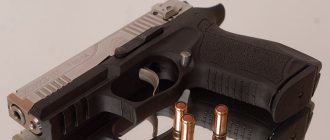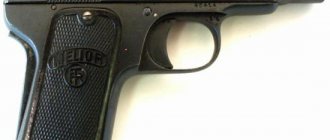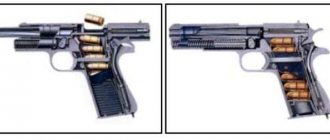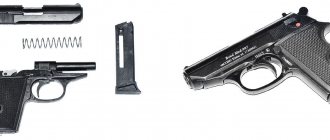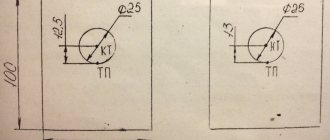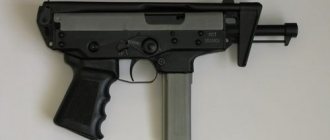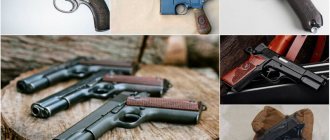Production and combat use
The first three thousand pistols were made of alloy steel (as a result, the cost of one pistol was 117 zlotys).
Subsequently, pistols were made of carbon steel. Technological changes were made to the production process, as a result, by the beginning of September 1939, the cost of production of one pistol was reduced to 84 zlotys. On pistols of the latest modification, there was no groove on the back wall of the handle for attaching an attached buttstock or a holster-buttstock.
Before the start of World War II, the Polish army received 60,216 pistols of this model, which were in service with tank crews, air force flight personnel and some cavalry units of the Polish army (at the same time, the bulk of the Polish army was still armed with Nagant revolvers). After the occupation of Poland, the production of the ViS-35 was continued; the pistols entered service with the German army, navy, some units of the SS troops and police forces. In total, 385 thousand VIS pistols entered service with German forces (this number includes both Polish pre-war pistols and wartime pistols issued in the “General Government”).
In total, 31 thousand ViS-35 were produced at the arms factory in Radom, another 310 thousand under the name P-35(p)
was produced during the occupation under ; In addition, a number of pistols were taken from the factory piece by piece by members of the Resistance movement. Production of the ViS-35 ceased after the Radom plant was destroyed by air raids in 1944. However, a number of pistols were still assembled in the period before April 1945 at the Steyr factory in Austria.
Wartime P.35(p) pistols were manufactured using a simplified technology (on the surface of the parts of these pistols traces of processing with a metal-cutting tool are visible, the bluing wears off faster) and from metal of poorer quality, which is why their reliability and service life have somewhat decreased.
- On pre-war ViS-35 pistols, handle cheeks with the letters “FB” (“Fabryka Broni”), stamped from copper and painted with black paint, filled with tin to prevent dents, were installed on one side. On the other side, the cheek had the inscription “VIS”. On wartime P.35(p) pistols, wooden or carbolite cheeks of a simplified design with fine transverse corrugation were installed.
- In comparison with pre-war pistols, the quality of pistols in recent years of production has deteriorated significantly.
After the war, serial production of the ViS-35 at the Radom plant was no longer resumed; instead, the Polish army used Soviet TTs. After the end of production of the Vis.35 in April 1945, this weapon was manufactured from 1997 to the present day only in limited editions. So, in 2014, the highly qualified Polish gunsmith Ryszard Tobis, the author of copies of ancient weapons and rare Polish models, made a replica of the Vis.35 chambered for the .45 ACP cartridge. In 2016, the Radom Arms Factory “Luchnik” released a limited edition replica of the original Vis.35 pistol in the amount of only 50 copies as a collector’s weapon.
Pistols | Radom ViS 35 (Radom ViS wz.1935)
The Polish pistol Radom ViS 35 was created by Piotr Wilniewczyc and Skrzypinski, after whom the pistol was named - Wilniewczyc i Skrzypinski (Wilniewczyc and Skrzypinski), and was mass-produced at the Fabryka Broni w Radomiu plant in Poland.
The pistol passed state tests in January 1931, in 1933 the Polish government bought the patent from the designers and in 1936 the pistol was officially adopted by the Polish Army, and its mass production also began. During the occupation of Poland by Germany, the ViS 35 was produced for the German armed forces. The Steyr-Daimler-Puch AG concern controlled the work of the occupied plant; in total, during the occupation, more than 350,000 pistols were produced in three versions (see below). Before the arrival of Soviet troops in August 1944, all parts for the ViS 35 pistols were exported to the Czech Republic, to a plant in the city of Znaim, which was also under the control of the Steyr-Daimler-Puch AG concern. A number of pistols were collected here until, on the night of January 2-3, 1945, Soviet aviation bombed the plant. The last 26 Radom ViS wz.1935 pistols were assembled in 1992, as part of an experiment to establish the production of the MMG pistol. The automatic pistol operates on the principle of a short barrel stroke. When fired, the barrel bore is locked by the engagement of two lugs with the casing - the bolt. When turned on, the safety retracts the firing pin into the firing pin channel and the trigger cannot strike it. Impact - single action trigger mechanism. The magazine release button is located behind the trigger guard opening. The part behind the grip that looks like the automatic safety button on a Colt 1911 pistol is the latch that holds the bolt in place. The pistol sight is open and not adjustable. The pistol is carried in a leather holster equipped with a pocket for two spare magazines and cleaning. There were also options with an attached holster - butt.
- .22 LR ViS
- ViS wz.1935 pistol for .22 LR caliber, slightly longer barrel, 10-round magazine. - .45 ACP ViS
- ViS wz.1935 pistol for .45 ACP caliber, 7-round magazine. - P.35(p)
- the name of the ViS wz.1935 adopted by the Wehrmacht, produced from 1941 to 1943. It is distinguished by the absence of grooves for attaching a holster - butt on the back of the handle. The delivery set includes two magazines, not three, as was the case with the pre-war ViS 35. - P.35/II(p)
- modification produced from 1943 to November 1944. Externally, it is distinguished by the absence of a bolt latch behind the handle; the lining on the handle is wooden. - P.35/III(p)
- modification of ViS wz.1935, assembled from exported parts. The finishing quality of these pistols is very poor.
P.35/II(p) - modification produced from 1943 to November 1944.
Externally, it is distinguished by the absence of a bolt latch behind the handle, the lining on the handle is wooden
Tactical and technical characteristics of the pistol PYa
| Performance characteristics | PY |
| Caliber, mm | 9x19 |
| Length, mm | 198 |
| Height, mm | 145 |
| Width, mm | 38 |
| Store capacity, pcs. cartridges | 18 |
| Weight of pistol with magazine without cartridges, kg, no more | 0,95 |
| Accuracy of fire - the size of dispersion of 4 or 3 holes with one detached | 150 |
| Firing accuracy - deviation of the average point of impact (MAP) of 4 holes or 3 holes with one detached from the control point (CP) when shooting at a distance of 25 m, no more, mm | 75 |
| Barrel length, mm | 112,5 |
| Number of rifling in the bore | 6 |
| Weight of one cartridge, g | 9,5 |
| Chuck length, mm | 29,7 |
| Combat rate of fire, rounds per minute | 35 |
| Initial flight speed of the 7N21 cartridge bullet, m/sec. | 465 |
| Warranty time, number of shots | 4000 |
Incomplete disassembly of the PYa pistol
1) separate the magazine from the pistol, to do this, take the pistol by the handle and press the magazine latch with your thumb. Separate the magazine released from under the latch tooth from the pistol with your free hand;
2) check that there is no cartridge in the chamber, to do this, turn off the safety (turn the flag down), move the bolt to the rear position by hand, inspect the chamber, release the bolt and perform a control release of the hammer;
3) separate the lock from the frame by pushing it out on the right side of the gun and, holding your fingers near the lock rod on the left side of the gun, remove it from the hole in the frame;
4) separate the bolt from the barrel, moving the frame forward along the guides;
5) separate the barrel with the rod and return spring from the bolt, for which, holding the protruding part of the coupling, rotate the barrel and move it forward until the breech exits the bolt rammer and separate the barrel with the rod and return spring;
6) disconnect the rod and return spring from the barrel.
| Video clip about the PYa pistol |
| An excerpt from the film “Domestic Small Arms” telling about PY |
Design and principle of operation of the PYa pistol
| 1 Trigger hook2 Trigger3 Barrel4 Shutter5 Striker spring6 Sear spring7 Magazine body8 Frame9 Contactor10 Magazine latch stopper11 Rod12 Return spring13 Reflector14 Pusher15 Action spring16 Pin17 Trigger hook axis | 18 Trigger rod19 Fuse20 Magazine cover21 Ejector22 Ejector bend23 Ejector spring24 Rear sight25 Drummer26 Feeder27 Magazine latch28 Magazine latch spring29 Magazine latch retainer30 Sear31 Magazine spring32 Trigger spring33 Thrust axis34 Handle | 35 Handle stop latch36 Handle stop37 Stop38 Safety flag39 Front sight plug40 Insert41 Pin42 Rear sight plug43 Safety lock44 Lock spring45 Pin46 Magazine latch plug47 Trigger pin48 Rail 49 Frame pin50 Pin |
According to the principle of automatic operation, the PYa pistol belongs to systems using the recoil energy of the bolt with a short barrel stroke. When the Yarygin pistol is in operation, the bolt is engaged with the barrel by means of a clutch with the front surface of the window to reflect the cartridge case, and decoupling is due to a cam groove on the clutch. The essence of the operation of a PYa pistol when firing is as follows: when you press the trigger with your finger, the trigger is released from the sear and strikes the firing pin, which breaks the cartridge primer with its striker. As a result, the powder charge ignites. The bullet is ejected from the barrel by the pressure of the powder gases. The bolt, together with the barrel attached to it, moves back under the influence of the pressure of the powder gases transmitted through the bottom of the cartridge case. After a short stroke, the barrel disengages from the bolt and the bolt moves further back without the barrel, holding the cartridge case with the ejector and compressing the return spring. When the cartridge meets the reflector, it is thrown out through the shutter window. When the bolt rolls back to its rearmost position, it turns the hammer back and cocks it. Having moved back all the way, the bolt returns forward under the action of the return spring. When moving forward, the bolt rammer grabs the next cartridge from the magazine and sends it into the chamber. When rolling, the bolt with its rim captures the barrel and further rolling to the extreme forward position is carried out by the bolt together with the barrel. In the extreme forward position, the barrel engages the bolt. The bore is locked by the mass of the bolt. The pistol is ready to fire again. To fire the next shot, you need to release the trigger and then press it again. In this way, shooting can be carried out until the cartridges in the magazine are completely used up. Once all the cartridges from the magazine have been used up, the bolt locks and remains in the rear position. The trigger mechanism of the PYa pistol is hammer-type with an open hammer and the possibility of self-cocking. The PY pistol magazine capacity of up to 18 rounds is ensured by the double-row arrangement of cartridges in the box magazine. Through the holes in the body it is possible to visually determine the number of cartridges in the magazine.
Modifications of the Mi-35 helicopter
- Mi-35 is an export helicopter based on the Mi-24V. The technology has changed the ASP-17V sighting system and the engines produced by Motor Sich - Klimov TVZ-117V.
- Mi-35P is an export model of the previously created Mi-24P. The rotor system, three-bladed tail rotor, long wing and retractable landing gear are typical of the Mi-24P. As for weapons, there is a fixed cannon mount, on which a double-barreled GSh-30K cannon (30 mm caliber) was installed.
- Mi-35PN is the same Mi-35P, with additions for performing combat missions at night. The Zarevo system is installed - a night sight-type television system. The crew is equipped with specialized night vision goggles (NVGs).
- Mi-35 PM is a doublet version of the Mi-35P with new X-shaped tail and main rotors with blades made of composite materials.
- Mi-35M is equipped with a non-retractable landing gear that protects the helicopter when falling (absorbs part of the impact), OPS-24N and its inherent gyro-stabilized optical-electronic system GOES-324, a laser rangefinder, a shortened wing and VK-2500 Klimov engines.
This aviation-military vehicle is in service with Russia (24 Mi-35M units and an order for 49 helicopters), Azerbaijan (16 Mi-35M units and an order for 24 helicopters of the same marking), Venezuela (10 Mi-35M2), Indonesia (seven representatives of the P marking), Myanmar (50 Mi-Ps available), Peru (two Mi-35P helicopters and a contract has been signed for two more Mi-35Ps), Afghanistan (9 Mi-35 helicopters).
Currently used for military purposes in Iraq.
History of creation
After the declaration of independence on November 12, 1918, the Polish Republic was armed with a variety of small arms remaining after the end of the First World War. By the end of the 1920s, there was a need to replace these weapons with modern models. The Armament Department negotiated the purchase of a license to manufacture the Czechoslovakian CZ.24 pistol designed by Josef Nikl. A batch of these pistols was purchased for the border guards, but it turned out that the sample did not meet the requirements for an army pistol.
During the negotiations, engineer P. Vilniewczyc (who at that time worked as a ballistics expert and technical adviser to the directorate of the state arms factory in Radom), offered a pistol of his design. The technical justification, description and drawing were prepared in two days. The project was carried out retroactively (to create the impression that work on it was already in full swing), approved by the weapons department and accepted for execution. In working on the detailed technical documentation, Wilniewczyc was assisted by engineer Jan Skrzypiński, director of the state rifle factory in Warsaw.
At the end of 1930, the first samples of the pistol were produced. Tests of the weapon were carried out already in 1931; based on their results, an application was submitted to the patent office of the Polish Republic on March 8, 1932, and on March 22, 1933, the designers were issued patent No. 15567[1].
By the spring of 1933, 650 thousand zlotys were allocated to launch mass production of the pistol at the arms factory in Radom, and in 1935 it was put into service under the official name “ 9 mm military pistol VIS model 35”
».
Initially, the pistol was planned to be called “WiS” - after the first letters of the designers’ last names, but at the request of the weapons department, the first letter was replaced with “V” (from the Latin VIS - “strength”)[1].
Mi-35 characteristics:
- Crew: 2 (pilot and weapons operator)
- Passenger capacity: up to 8 soldiers or 2 stretchers with seriously wounded and a paramedic
- Load capacity: 2400 kg
- Length: n/a
- Fuselage length: 17.51 m
- Main rotor diameter: 17.3 m
- Tail rotor diameter: 3.91 m
- Maximum fuselage width: 1.7 m (6.66 m with wing panels docked)
- Height: 3.97 m (with tail rotor)
- Area swept by main rotor: m²
- Chassis base: 4.39 m
- Chassis track: 3.03 m
- Empty weight: 8620 kg
- Normal take-off weight: 11,200 kg
- Maximum take-off weight: 11,500 kg
- Fuel mass in internal tanks: 1500 kg + optional 1000 kg
- Fuel tank volume: n/a (+ 4 x 500 l in PTB)
- Powerplant: 2 × Klimov TV3-117VMA turboshafts produced by Motor Sich
- Engine power: 2 × 2200 l. With. (takeoff)
9-mm pistol Yarygin PYA (index 6P35)
| The 9 mm Yarygin 6P35 pistol is a personal weapon of attack and defense, designed to hit targets using 9 mm pistol cartridges with a bullet of increased penetration (index 7N21) at a distance of up to 50 m, at ambient temperatures from minus 50 ° C to + 50 ° C, while at a distance of up to 25 m, it ensures the destruction of targets protected by body armor of the Zh-81, Zh-86-2 type. |
At the beginning of 1991, the Main Missile and Artillery Directorate of the USSR Ministry of Defense issued tactical and technical specifications for the development of a new army pistol. The experimental design work received the code “Rook”. Development was carried out at the Izhevsk Mechanical Plant, at TsNIITOCHMASH in Klimovsk, at TsKIB SOO in Tula, and later the Tula Instrument Design Bureau joined in. The designers of the Izhevsk Mechanical Plant presented three experimental pistols, among which was a pistol designed by V. A. Yarygin chambered for 9×18 PM, PMM and 7.62×25 TT. The Ministry of Defense of the Russian Federation has clarified the requirements for the new army pistol. Among other things, the possibility of using 9x19 Parabellum cartridges, which would expand the export capabilities of the pistol. Izhmekh had already developed a Yarygin pistol chambered for the 9×19 cartridge; after the creation of the domestic 7N21 cartridge, the pistol was modified for it. In 1998-1999 passed state tests of new pistols - Izhevsk 6P35 by V. A. Yarygin, Klimov 6P35 and SR1, Tula GSh-18. The cartridges were also improved. The Izhevsk model of the Yarygin system (YA) was recommended for adoption by the Russian army. The Yarygin PYa pistol (index 6P35) chambered for the 9×19 cartridge was adopted by the Russian Government by Decree of the Government of the Russian Federation of March 21, 2003.
Pistol Radom ViS 35 (Radom ViS wz.1935)
I have always liked weapons from the beginning of the last century for their quality, but I am not a collector. Another thing is information about weapons, which I never miss the opportunity to read and save. I shared with you the available information about the VIS wz 35 pistol, but I am not its owner. Of course, it’s nice to feel like the owner of a well-preserved VIS wz35, especially up to serial number 3000 (the first pistols before this number were produced with high-quality stainless steel), but for this you need the excitement of collecting and I'm just a user. The accuracy of fire of any pistol depends on the condition of the pistol and the skills of the shooter, and the range is approximate for all pistols of a similar caliber. Don’t be fooled by the large numbers on the bar, remember this is a pistol and not a rifle. I don’t know where you live, but if you want to buy a pistol not for collection but for real shooting, then there are lighter and more modern pistols for this.
To the complete information that Dear Colleague kolobok provided you, I can add that in F. Babak’s book “Revolvers and Pistols” there is his detailed explosion diagram. And on the Internet his explosion diagram is here: https://lapetoire.free.fr/public/mod%20poing/R/Radom%20P35.jpg
To the complete information that Dear Colleague kolobok provided you, I can add that in F. Babak’s book “Revolvers and Pistols” there is his detailed explosion diagram. And on the Internet his explosion diagram is here: https://lapetoire.free.fr/public/mod%20poing/R/Radom%20P35.jpg
Now I have a question for you. Tell me, did they spoil the production of your MMG VIS wz.35 from what period of production? The point is that these pistols could have entered the territory of the USSR during the war as captured and confiscated from the population in the post-war period. In both cases, these could have been pistols of different periods of manufacture and of different quality, but there was one more point. The first pistols of the best quality went into service with career officers of the Polish Army, a considerable part of which retreated from Poland in 1939, keeping light weapons with them. Thus, some of the pistols ended up in weapons depots of the USSR, which is confirmed by facts from Katyn, because I’m interested in what they are cutting into metal now.
Now I have a question for you. Tell me, what production period was spoiled for the production of your MMG? VIS wz.35? kolobok! I have had my MMG VIS wz.35 for over a year now. So I've already played enough
and haven’t held it in my hands for a long time. I'm not much of a collector either. I remember that when I first acquired it, after researching the issue in the literature, I came to the conclusion that it was a German trophy (German stamps, bolt markings.) I’ll be at home, I’ll take a look, refresh my memory and tell you in more detail. I can post pictures too. Yes, it's an interesting question. I don’t know how it is in Russia, but among MMG collectors in Ukraine, such exotic things pop up like dear mother! And of course it costs a lot of money! Yes, everything is castrated, but what do they have left for the poor fellows? As Golokhvastov said: “it’s the wrong color and it’s already lost.” That’s the same with the “castrato”: you can look at the marks, throw them up, click them. But there is no trembling in my soul! Dead man. Picking up a banal PM at the shooting range is much more interesting than any castrated exotic. Living is living!
Notes
- ↑ P. Vilniewchits. VIS pistol: memories of the developer // “Soldier of Fortune” magazine, No. 10 (121), October 2004. pp. 45-48
- V. A. Kashevsky. Infantry weapons of the Second World War. Minsk, Harvest LLC, 2004. p.90-92
- Foreign-made military and service pistols in the armed forces of the Third Reich // “Weapons” magazine, No. 2, 2001 (special issue “Infantry weapons of the Third Reich. Part II. Pistols”) p.9
- ↑ A. I. Blagovestov. What they shoot from in the CIS / ed. A.E. Taras. Minsk, “Harvest”, M., LLC “AST Publishing House”, 2000. pp. 154-156
- Ian Hogg. Firearms (Jane's Directory). M., “Astrel - AST”, 2004. p.67
Links[edit]
- ^ abcde (in Polish) Twardoch, Szczepan, VIS-a-VIS
in
Broń i Amunicja
nr. 3/2007, pp.48–51, ISSN 1644-339X - https://www.muzeumwp.pl/emwpaedia/pistolet-vis-wz-35.php
- https://www.youtube.com/watch?v=mSnEVHCpggk
- ^ abc York, William J. (2011). VIS Radom, sketch and photo album of the best pistol in Poland
. Printed and bound in the USA. pp. 22–24. ISBN 0-9707997-8-0. - ^ abc Bishop, Chris (2006). Encyclopedia of Small Arms and Artillery
. Grange Books. pp. 13–14. ISBN 978-1-84013-910-5. - ^ abcd (in Polish) Weiler, Wojciech: VIS
in:
Przegląd Strzelecki Arsenał
nr. 2/2004 (4), pp.51–60, ISSN 1731-190X - Remigiusz Wilk, Bez nowości, ale z Bumarem
, “Raport-WTO” nr. 03/2011, p.46 (in Polish) - Remigiusz Wilk, “Vis na rynku od 2018”, MILMAG website, available at [1] (in Polish)
- Gianluigi, Usay; Riccio, Ralph (28 January 2022). Italian guerrilla weapons in World War II
. Schiffer Military history. paragraph 126. ISBN 978-0764352102.
- Lapin, Terence W. (2004). Vis: Pistol Radom Model 35
. Arlington: Hyrax Publishing. ISBN 0-9676896-4-3. - Andrzej Cieplinski, Ryszard Wozniak (1996). Self-propelled pistol 9 mm VIS wz.
1935 . Warsaw: Bellona. ISBN 83-11-08604-4.
